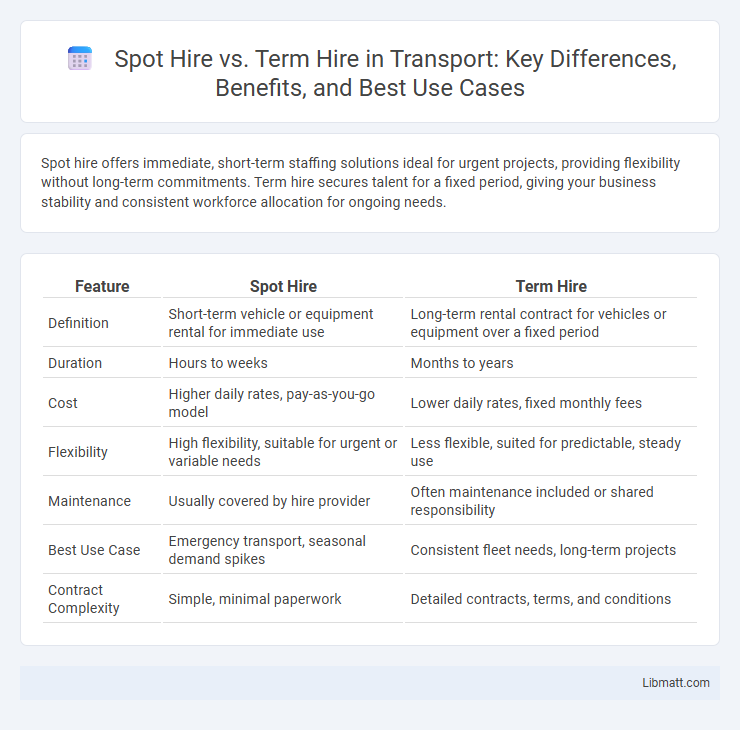Spot hire offers immediate, short-term staffing solutions ideal for urgent projects, providing flexibility without long-term commitments. Term hire secures talent for a fixed period, giving your business stability and consistent workforce allocation for ongoing needs.
Table of Comparison
| Feature | Spot Hire | Term Hire |
|---|---|---|
| Definition | Short-term vehicle or equipment rental for immediate use | Long-term rental contract for vehicles or equipment over a fixed period |
| Duration | Hours to weeks | Months to years |
| Cost | Higher daily rates, pay-as-you-go model | Lower daily rates, fixed monthly fees |
| Flexibility | High flexibility, suitable for urgent or variable needs | Less flexible, suited for predictable, steady use |
| Maintenance | Usually covered by hire provider | Often maintenance included or shared responsibility |
| Best Use Case | Emergency transport, seasonal demand spikes | Consistent fleet needs, long-term projects |
| Contract Complexity | Simple, minimal paperwork | Detailed contracts, terms, and conditions |
Understanding Spot Hire and Term Hire
Spot hire involves recruiting temporary personnel for immediate, short-term projects or urgent staffing needs, offering flexibility and rapid deployment without long-term commitment. Term hire refers to employing staff for a fixed contract duration, typically spanning several months to a year, providing stability and focused expertise aligned with specific project timelines. Both hiring methods optimize workforce management by balancing agility and resource allocation based on organizational demands.
Key Differences Between Spot Hire and Term Hire
Spot hire offers temporary staffing solutions for immediate, short-term needs, usually ranging from a few days to several weeks, providing flexibility and quick workforce scaling. Term hire involves contractual employment for a fixed duration, often months to years, ensuring continuity and stability for projects requiring dedicated resources without the long-term commitment of permanent employment. Key differences include contract length, cost implications, and suitability based on project scope and organizational workforce planning.
Advantages of Spot Hire
Spot hire provides immediate access to skilled workers, allowing businesses to quickly fill short-term gaps without long-term commitments. It offers cost efficiency by reducing overhead expenses associated with permanent staff, such as benefits and training. Your project benefits from flexibility, adapting workforce size to fluctuating demands while maintaining operational continuity.
Advantages of Term Hire
Term hire offers stability and consistent workforce availability, reducing recruitment frequency and associated costs. It ensures employees are aligned with your project timelines or business goals, enhancing productivity and team cohesion. This approach also provides better opportunities for skill development and long-term planning, supporting sustainable growth for your organization.
Cost Comparison: Spot Hire vs Term Hire
Spot hire typically incurs higher hourly or daily rates due to its short-term flexibility and immediate availability, making it more expensive for extended projects. Term hire offers more cost efficiency with fixed monthly or yearly salaries, reducing overhead for long-term staffing needs. Businesses save significantly by opting for term hire in ongoing operations, while spot hire suits urgent, short-duration demands despite the premium cost.
Situational Suitability: When to Choose Spot Hire
Spot hire suits projects requiring immediate, short-term workforce flexibility without long-term commitment, often ideal for seasonal spikes or urgent skill gaps. Term hire fits scenarios needing specialized skills for extended periods, ensuring continuity and reduced turnover risk. You should evaluate project duration, budget constraints, and skill specificity to decide which hiring method aligns with your operational goals.
Situational Suitability: When to Choose Term Hire
Term hire is ideal for projects requiring specialized skills over a fixed duration, ensuring workforce stability without long-term commitment. It suits seasonal workloads, product launches, or regulatory compliance tasks where consistent expertise is critical. Opting for term hire minimizes recruitment cycles and onboarding overhead while maintaining productivity continuity.
Impact on Operational Efficiency
Spot hire allows your business to quickly fill short-term staffing gaps, minimizing downtime and maintaining workflow continuity. Term hire provides stability with dedicated employees for a fixed period, fostering consistent productivity and reducing onboarding time compared to frequent spot hires. Choosing the right mix between spot hire and term hire directly impacts operational efficiency by balancing flexibility and workforce stability.
Industry Trends in Spot and Term Hiring
Spot hire offers businesses flexibility to quickly fill temporary skill gaps driven by fluctuating project demands, aligning with industry trends favoring agile workforce management. Term hire provides stability for organizations seeking specialized talent for fixed project durations, reflecting the growth in contract-based engagements across sectors like IT, construction, and healthcare. Your strategic choice between spot and term hiring can optimize resource allocation amid evolving labor market dynamics and talent shortages.
How to Decide: Factors Influencing Hire Type Choices
Choosing between spot hire and term hire depends on project duration, budget constraints, and skill specialization required. Spot hire suits short-term, urgent needs with flexible budgets, while term hire is ideal for sustained roles demanding consistent expertise and cost efficiency. Evaluating workforce planning, project scope, and financial impact guides businesses to align hire types with operational goals.
spot hire vs term hire Infographic

 libmatt.com
libmatt.com